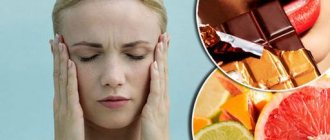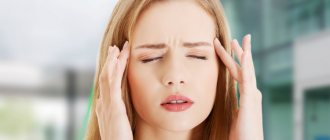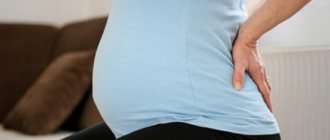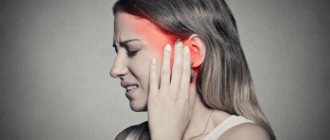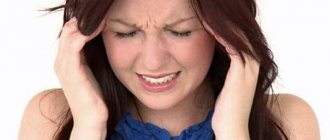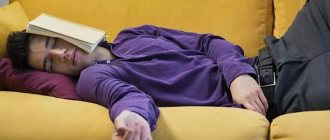Causes of headaches during breastfeeding
Headaches are not an independent symptom, but a manifestation of a number of disorders. These may be factors such as hormonal imbalance, vitamin deficiency, as well as pathologies of individual organs and systems. During breastfeeding, tension headaches and migraines often occur, as well as those associated with changes in hormonal levels.
Tension headaches
Main article: Tension headache
This type of headache is often associated with stress, lack of sleep, and nervous tension. It is described as a sensation of squeezing the head in the form of a hoop, without additional symptoms such as nausea, increased sensitivity to light, and others. Tension headaches can be acute or chronic, but often go away after normalizing your sleep and rest schedule, as well as replenishing vitamin and mineral deficiencies.
Migraine
Migraine is one of the common types of headaches. It occurs independently and is not associated with pathologies of other organs and systems. Before an attack of pain, a migraine aura often appears, which is a complex of characteristic symptoms:
- increased sensitivity to bright light, lacrimation;
- increased reaction to loud sounds;
- nausea, dizziness, appearance of dark circles in the field of vision;
- rapid pulse.
Migraines often worsen in women during breastfeeding. The main reasons are sleep disturbances, hormonal changes, and increased anxiety. Specific potent drugs are used for treatment, but they are not recommended for use during breastfeeding. To improve your well-being, you can massage your neck and head, provide yourself with rest and use relaxing essential oils.
Other reasons
Headaches during breastfeeding are a consequence of the general condition of the body. They can occur for many reasons:
- increased levels of certain hormones in the blood;
- increased anxiety;
- lack of sleep, frequent awakenings at night;
- tension in the muscles of the neck and back.
It is important to understand that chronic spinal diseases may worsen during breastfeeding. During pregnancy and then when caring for a child, the load on the lumbar region increases, and problems in the cervical and thoracic regions may also arise. This affects the blood supply to the brain and can cause severe pain.
How to take care of yourself
Typically, migraine is a hereditary disease, so it cannot be completely eliminated. However, attacks can be made significantly less frequent and milder – and at home! – if you avoid additional provocateurs.
First of all, doctors recommend drinking enough fluids and eating regularly. It has been proven that long periods of hunger, as well as dehydration, can cause a migraine attack. It is equally important to get enough hours of quality sleep while also maintaining good hygiene: for example, not using gadgets with bright screens before bed.
Regular walks, jogging and airing the apartment will also have a positive effect on your well-being. All kinds of relaxation techniques are also useful: from yoga to auto-training and breathing exercises. Finding time for yourself can be difficult, but for expectant and new moms with migraines, it's absolutely essential. It’s good if you can enlist the support of your husband, mother or girlfriend: even an hour or two of free time can be enough to come to your senses.
Separately, in the list of migraine provocateurs, it is worth highlighting depressive and anxiety disorders. Perinatal depression is a sad reality for many women; Moreover, it has been proven that emotional stress is one of the main causes of migraine attacks. Therefore, if you feel that you cannot cope with your anxiety for your child, or that fatigue is developing into something more, you do not need to endure it - it is better to consult a psychologist in time. Psychotherapy is an effective means of combating not only depression, but also migraines; especially during pregnancy and breastfeeding, when antidepressants are contraindicated.
Diagnostic methods
Comprehensive diagnosis is an important stage for prescribing competent treatment. It is important to determine what caused the headaches in order to select effective and safe medications. The doctor may prescribe the following stages of examination:
- general and biochemical blood tests;
- determination of hormone levels in the blood;
- diagnostics of the condition of the heart and blood vessels (pressure measurement, electrocardiography, Dopplerography of the vessels of the neck and head);
- radiography of the thoracic and cervical spine;
- MRI, CT as necessary.
At the Clinical Brain Institute, you can undergo a full examination to determine the cause of headaches during breastfeeding. In our center, diagnostics are carried out using modern equipment, which allows us to obtain the most accurate results.
What about medical care?
For pregnant and lactating women, doctors insist on non-drug methods of therapy. The reason for this is the ability of the molecules of many medications to act on the child through the placenta or through breast milk. Of course, a one-time dose of paracetamol is not dangerous, but most other drugs that are used to treat and prevent migraines cannot be prescribed during the perinatal period.
For ethical reasons, most of the data collected by scientists on the safety of medications for the fetus is obtained not from clinical studies, but from surveys of women who took certain medications during pregnancy. Such post-hoc analysis cannot replace blind testing, the gold standard for pharmaceutical safety. Drugs are also tested on animals, and such studies can also serve as confirmation of safety - but still indirect.
Drug safety reminderDoctors in different countries have developed different standards for assessing the potential risks of a particular drug. The most famous of them was introduced by the FDA (Food and Drug Administration) - the Food and Drug Administration in the United States. According to the FDA classification, drugs are divided into categories:
Paracetamol is classified as Category B, but one of the most common prescriptions for migraines, triptans, cannot be prescribed during pregnancy. Ibuprofen is allowed to be taken in the second trimester, but aspirin will have to be completely abandoned. |
If the effect on migraine at home is still not enough, you can use non-drug therapy methods.
The method of biofeedback, acupuncture, as well as methods of hardware influence on the trigeminal nerve have shown effectiveness. It is the trigeminal nerve that is the “culprit” of migraine attacks; and since its branches are close to the skin in the forehead area, it is possible to exert electromagnetic influence on it gently but effectively. In Russia, only one device is registered that affects the branches of the trigeminal nerve - a special hoop with a Cefali electrode. It has passed all clinical studies of effectiveness and safety, is approved by the FDA and complements other types of migraine therapy and prevention.
Treatment of headaches
To relieve pain, you can use simple painkillers that are safe for children: paracetamol, ibuprofen, ketoprofen. Potent drugs are contraindicated because they can pass into milk. There are also ways to relieve pain without using drugs:
- provide yourself with rest, try to establish a sleep schedule;
- take a warm bath with the addition of sea salt and herbal infusions;
- apply a few drops of essential oils (lavender, mint, eucalyptus) to the area behind the ears;
- massage your neck and head.
The doctor will prescribe complex treatment for back diseases and circulatory disorders after breastfeeding is completed. During this period, it is important to avoid stress and follow general recommendations.
Instructions for use of Viferon gel, suppositories and ointment for nursing mothers
Scheme for using the antiviral drug VIFERON Gel during breastfeeding
| Disease | Frequency/duration of use | Mode of application |
| ARVI and influenza (treatment) | 3–5 times a day / 5 days | A strip of gel no more than 0.5 cm long is applied to the previously dried surface of the nasal mucosa |
| ARVI and influenza (prevention) | 2 times a day / 2–4 weeks | |
| Herpes infection of the skin and mucous membranes | 3–5 times a day / 5–6 days | A strip of gel no more than 0.5 cm long is applied using a spatula or a cotton swab / cotton swab to a pre-dried affected surface 3-5 times a day |
Scheme for using the antiviral drug VIFERON Ointment during breastfeeding
| Disease | Frequency/duration of use | Mode of application |
| Herpes infection of the skin and mucous membranes | 3–4 times a day / 5–7 days | It is recommended to begin treatment immediately when the first signs of damage to the skin and mucous membranes appear (itching, burning, redness). |
| ARVI and influenza (treatment) | 3–4 times a day / 5 days | The ointment is applied in a thin layer to the mucous membrane of the nasal passages |
Scheme of use of the antiviral drug VIFERON Suppositories (rectal suppositories) for nursing mothers
| ARVI and influenza | 5 days VIFERON® 500,000 ME |
| Herpetic infection | 10 days VIFERON® 1000,000 ME |
| Urogenital infections, including human papillomavirus infection | 5-10 days VIFERON® 500,000 ME |
Author of the article
Belyaev Dmitry Alexandrovich
General doctor
Reference and information material
Loading...
Take other surveys
Prevention methods
The first months of a child’s life are a huge responsibility and stress. At this time, the mother’s body experiences heavy stress, to which it reacts with a prolonged headache. However, if you follow several recommendations from doctors, you can avoid deterioration in health and other dangerous consequences:
- use pillows and other feeding devices - they relieve stress on the spine;
- eat well, take complexes of vitamins and microelements if necessary;
- take time for walks - a sufficient amount of oxygen is necessary to nourish brain cells;
- Avoid stress and allow yourself periodic rest.
At the Clinical Brain Institute, you can undergo a complete examination, which will allow you to quickly and accurately determine the cause of your headaches. The doctors of our center are specialists of a narrow and broad profile with many years of experience in treating various diseases. The effectiveness of therapy will depend on the timely use of prescribed medications, as well as on the implementation of additional recommendations, including adherence to diet and regular exercise.
Clinical Brain Institute Rating: 5/5 — 1 votes
Share article on social networks
Preventing and combating migraines without drugs
Prevention can help you avoid or reduce the number of headache days. The recommendations are:
- try to get enough sleep. We, of course, know that few people manage to sleep normally in the first months of birth. But if you have migraines, take a closer look at your sleep patterns;
- avoid hunger and overeating, dehydration, as well as foods that can trigger attacks in your case (we have an article “What causes migraine attacks” on this topic);
- try to avoid stress;
- Keep a headache diary to identify attack triggers and take control of them. The diary does not have to be paper; Telegram has a free and convenient bot that helps track data about your headache - Migrbot. You can learn more about it here: migrebot.com.
These simple tips may seem unconvincing. But, believe me, they will help make attacks less frequent (by eliminating factors that provoke migraines)!
You can also use the following non-medicinal methods (used in world practice):
- Cognitive behavioral psychotherapy.
- Biofeedback therapy. A system in which a person, using sensors, understands how to control certain functions of his body: muscle tone, breathing, heartbeat, and thus, for example, learns to relax.
- The Cefali device is a headband that uses electrical impulses to relieve or relieve headaches.
